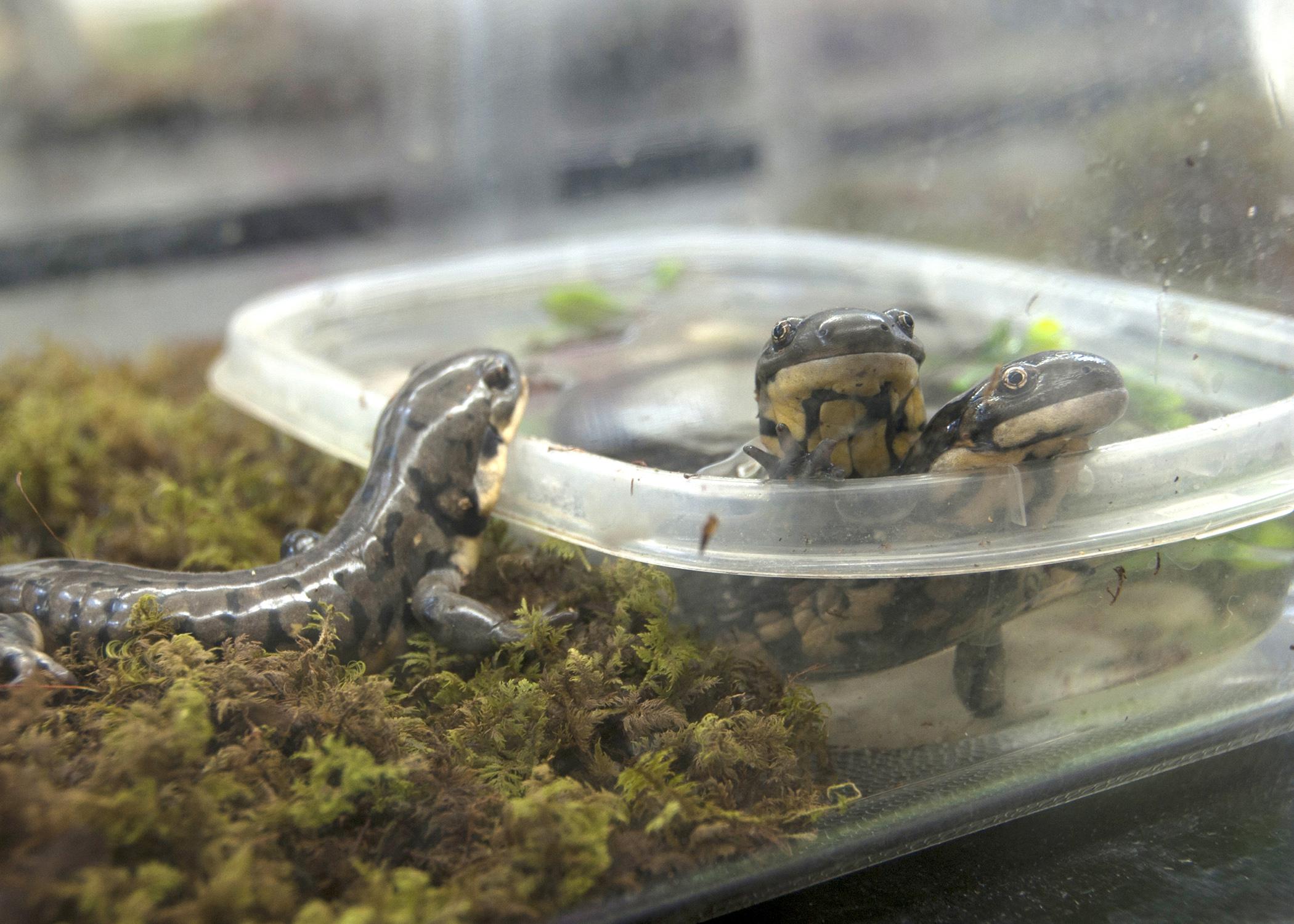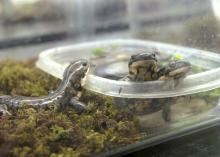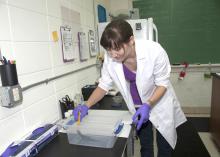Information Possibly Outdated
The information presented on this page was originally released on August 2, 2013. It may not be outdated, but please search our site for more current information. If you plan to quote or reference this information in a publication, please check with the Extension specialist or author before proceeding.
MSU salamander work has conservation impact
MISSISSIPPI STATE – A tough bunch of salamanders found a home in a brand-new lab at Mississippi State University, where they are helping researchers learn how to keep populations of these amphibians from declining worldwide.
The 62 tiger salamanders took a long road before reaching MSU. They came from Nevada by way of Iowa and the Omaha Zoo before arriving at a Mississippi Agricultural and Forestry Experiment Station lab at MSU.
Amphibian populations are shrinking, and scientists don’t know why. Globally, 50 percent of salamanders and 30 percent of frogs are threatened, which could be a sign of diminishing ecosystem health.
Scientists and avid salamander fans Dr. Ruth Marcec and Hannah Bement are studying and caring for MSU’s new amphibian colony through a research program in partnership with the Memphis Zoo. Marcec, a veterinarian, and Bement are both working on doctoral degrees in animal physiology at MSU, using the amphibians as models in an investigation that could help protect salamanders in the wild.
“Salamanders are an important part of the overall environmental picture,” Bement said. “They help regulate pest insects and help move nutrients up the food chain. They also are important for medical research.”
Compared with birds and mammals, scientists know relatively little about salamanders and other amphibians, Marcec said. While knowledge about amphibian populations is limited, there is evidence of a wide-scale decline in many species.
“We are trying to establish captive breeding protocols,” she said. “The protocols available are only partially successful and were written for highly inbred lab species. They may not work with wild species.”
Marcec, who is originally from Georgia and Illinois, earned an undergraduate degree from Florida State University and a Doctor of Veterinary Medicine degree from the University of Illinois. Her love for salamanders drew her to MSU.
“I have a lifelong obsession with salamanders. When I was young, I always told people I wanted to be a salamander veterinarian,” Marcec said. “I heard about this new research at MSU and came June 1, 2012.”
Marcec and Bement built the amphibian lab from the ground up. They designed and constructed the habitats, bringing together water sources, filtering systems and chillers needed to create an ideal salamander sanctuary in a laboratory.
Special photographs of the salamanders are posted on the edges of each habitat, along with their names.
“We identify salamanders with their chins,” Marcec explained. “They have very unique patterns of spots and marks on their chins.”
Marcec and Bement drew on a variety of sources to give each salamander a name, such as Capt. Hook, Alibaba, Tulip and Olaf.
In the lab, the amphibians eat a carefully monitored diet of earthworms, mealworms and wax worms. Wild salamanders have a more varied diet.
“In the wild, they eat anything that fits in their mouths,” Marcec said. “They are ambush predators who bury themselves under the soil with just their eyes out until prey walks by.”
The MSU salamanders were part of a migrating group in Iowa whose path intersected a construction site. At breeding time, salamanders migrate sometimes hundreds of miles back to the ponds where they hatched. While moving across the construction site, dozens of the amphibians fell into ground-level window wells and were trapped.
The well-intentioned homeowner kept the salamanders in small wading pools, but the colony contracted the contagious and deadly Ambystoma tigrinum virus, or ATV. So many died that he contacted the Omaha Zoo for help.
MSU received the survivors of this ordeal. As ATV carriers, these salamanders cannot be released into the wild. This fact and their status as threatened, not endangered, made them ideal candidates for research to improve the population of their species.
Marcec and Bement keep this species of salamander, as well as aquatic salamanders called mudpuppies, in off-the-shelf plastic tubs that are either filled with moss or fitted with a source that brings in fresh, chilled water and pipes away water to be filtered.
The MSU scientists are addressing the fact that very little is known about salamanders in general and their reproduction in particular. Aside from providing subjects for research, captive colonies also preserve genetic diversity and serve as source populations for possible future reintroduction into the wild.
“There are efforts by scientists and governmental organizations to save these species in the wild or bring them into captivity to keep them alive. The problem in captivity is if you can’t get them to breed, you can still lose the species,” Bement said.
Salamanders fertilize their eggs internally through a unique process where the male creates a spermatophore, or ball of sperm, which he deposits for the female he is attracting. She picks up the spermatophore and later lays fertilized eggs.
In the lab, the researchers are using hormone therapy to encourage breeding. Until this process happens naturally in captivity, a simple form of in vitro fertilization keeps the salamanders reproducing.
“We put the eggs in a dish, squirt the semen on top of the eggs, let it sit five minutes and then add water,” Marcec said.
She focuses her efforts on the males.
“We’re trying to get a dose-response curve so we can know how to stimulate the boys and girls to provide gametes at the same time,” Marcec said.
Bement is specifically working with the females, using hormone therapy to get them ready to lay eggs.
“If they have eggs ready to go, I can get them to lay their eggs,” Bement said. “My challenge seems to be to get them to go through the cycle and be ready to drop eggs.”










